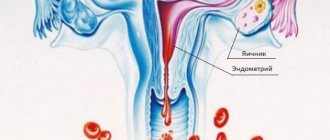Prevention of the condition
As a preventive measure it is recommended:
- maintain personal hygiene;
- use contraception when having sex with an untested partner;
- Healthy food;
- avoid severe stress and hypothermia, as well as excessive physical activity;
- give up bad habits;
- take any medications only in consultation with your doctor;
- Visit a gynecologist annually for preventative care.
The recommendations listed above help to avoid many problems that lead to disturbances in the cycle and nature of discharge.
Coming at the most inopportune moment, a strange brown smudge is very confusing. To avoid having dirty periods, follow these rules:
- Wash yourself every day. Don't overuse or neglect your shower.
- Choose a shower gel that's right for you. If the product causes itching and irritation in the genital area, choose something else.
- For the intimate area, buy a separate towel.
- Don't overexert yourself in the gym. Distribute the load rationally!
- Be positive. Don't get discouraged in stressful situations.
- Eat right. Eat everything, but in moderation. The body must receive all the necessary nutrients.
All diseases have similar symptoms, so contact your gynecologist if in doubt. The sooner you do this, the better. Do not self-medicate so that the disease does not go further and develop into oncology! Listen to the advice of friends and women on forums, but don’t attach much importance to them. Only a doctor can give an accurate diagnosis. Use online information for reference purposes only.
Gynecologist's recommendations
Thick and dark periods are not always an indicator of pathology. Sometimes a woman needs to rest, normalize her routine, establish proper nutrition, and this will have a beneficial effect on her cycle and menstruation.
To maintain reproductive health, you should listen to the following tips:
- Maintaining hygiene during menstruation. Gaskets should be changed at least once every 4 hours.
- If you do not have a regular sexual partner, use condoms.
- Balance your diet. The daily menu should include all useful substances, vegetables and fruits.
- To refuse from bad habits.
- Try to avoid stressful situations.
If thick, dark-colored discharge bothers you over several cycles, you should contact the clinic. The examination will identify diseases if they are present. Next, you will need to undergo treatment prescribed by the doctor.
Why do blood clots come out during menstruation?
It is considered natural to have blood clots during menstruation, which are released at the beginning of menstruation (2-3 days). During this period, detachment and active rejection of the obsolete layer of the endometrium, mucus and secretion occurs in the reproductive organ. By the end of the cycle, the discharge does not contain any foreign lumps or clots. If the menstrual cycle does not follow a similar scenario, there is cause for concern.
The appearance of blood clots at the initial stage of menstruation is normal
Table “Causes of heavy periods with thick, dark lumps”
| Provoking factors | How do they manifest themselves? |
| Disturbances in hormonal levels (during adolescence, after recent childbirth, during the decline of childbearing function) provoke endometrial atrophy, affect the composition and clotting of blood | Painful periods with clots in the form of large flakes are accompanied by migraines, loss of strength, and increased irritability. During menopause, bleeding between cycles, huge pieces with an unpleasant odor, heavy periods (requires changing pads every hour), brown clots are considered a pathological phenomenon. |
| Overgrowth of the endometrium (endometriosis) or ingrowth of the upper layer of the uterus into the internal tissues (adenomyosis) | Discharge comes in clots, the stomach swells, cycles are interrupted, going to the toilet becomes painful, discomfort and bleeding occur during sex. |
| Remains of the placenta after childbirth | Large clots that look like liver come out |
| Uncontrolled growth of epithelial cells that line the uterine cavity (endometrial hyperplasia) | Large clots may be present throughout the entire period. Discharge between cycles is possible, and the cycles themselves can be prolonged or become very short. |
| The appearance of endometrial polyps | Menstruation is painful, and the discharge contains small pink clots |
| The period after childbirth or abortion | Over the course of a month, huge pieces of blood clots come out. If there is no temperature, there is no need to worry. The body is cleansed |
| The appearance of endometrial cells outside the reproductive organ (endometriosis) | The menstrual period becomes unstable, pain appears, the volume of blood released increases noticeably, resulting in periods with black clots |
| Presence of a contraceptive device, use of contraceptives | Contraceptives interfere with the full release of secretions, temporary stagnation occurs, the blood quickly solidifies, which provokes large dark clots |
| Pregnancy outside the uterine cavity | Severe pain in the lower abdomen, there are many brown clots in the discharge, body temperature rises |
| Inflammation in the pelvic organs of an infectious nature | Copious discharge with large blood clots can accompany menstrual periods and appear after menstruation |
| Anomalies of the uterus of genetic etiology (intrauterine septum, homogeneous or double uterus, bending of the organ) | Due to anatomical features, blood begins to clot in the uterus and come out in small or large clots. Menstruation is painful, the woman’s health is poor (depressed, irritable, tired) |
| Colds that cause high fever | Small clots in the discharge, increased blood volume |
| Benign tumors in the uterine cavity (fibroids) | The regularity of menstrual periods is disrupted, the volume of discharge increases, large and sometimes huge clots similar to liver appear |
Concomitant diseases such as diabetes, hypertension, and disorders in the endocrine system can aggravate the condition during menstruation.
Pieces of blood during menstruation are not always pathological (after childbirth, during menopause, during a cold). If the discharge is moderate, regular, without pain or temperature, then the presence of dark lumps or pieces is the norm.
You need to worry in the following situations:
- heavy discharge with brown clots for more than 7 days;
- severe delay or discharge much ahead of schedule;
- large blood clots with an unpleasant odor;
- menstruation with clots is accompanied by severe pain, high fever, and poor health.
You should not ignore unpleasant symptoms - they may be a sign of serious inflammation or hormonal imbalance that requires treatment.
Individual characteristics of the menstrual cycle, menstrual cycle
Menstrual flow is the result of getting rid of the products of the reproductive system, which is observed monthly in adult females. Healthy menstrual discharge should not be thick or dark. That is why, if a woman has thick discharge during menstruation, then such symptoms are often signs of the development of certain pathologies. The most common reasons for a malfunction in the menstrual cycle, changes in the consistency of discharge, such as the situation when the discharge appears too thick during menstruation, are hormonal imbalances, which can occur for a number of reasons.
For all women, menstruation meets certain criteria: the duration of the cycle is from 19 to 45 days (the maximum period is, on average, from 28 to 31 days), and the menstruation itself is from 2 to 8 days. Discharge should appear regularly, cyclically and without delay, and not cause discomfort or pain. The blood released during critical days is darker than the rest of the blood flowing in human vessels and should not clot. The menstrual cycle, which has no deviations, consists of two phases, blood loss occurs during the first phase and has a volume of about 50-150 ml. Delayed menstruation occurs only in two cases: with the onset of pregnancy, or due to disturbances in the functioning of the body. Illness is indicated, in particular, by thicker than usual menstrual flow.
What are the reasons for the appearance of discharge?
When a woman bleeds from her vagina but does not have her period, there is always a reason for it. No treatment can be carried out until the precipitating factor is identified. Bleeding is not a disease, but only a consequence of pathological processes in the body.
Stress and anxiety can cause discharge in the middle of the cycle
Causes of spotting after or before menstruation:
- influence of stressful situations;
- development of erosion;
- severe overexertion (for example, after lifting weights or performing exercises that involve a lot of stress on the abdominal area);
- damage resulting from sexual intercourse (especially when using objects);
- pregnancy or self-abortion;
- use of an intrauterine device;
- performing an abortion;
- postpartum complications;
- gynecological diseases;
- diseases that cause decreased blood clotting.
Could the discharge be the result of an allergy?
An allergic reaction causes a disruption in the functionality of many body systems. Depending on the allergen, various symptoms of intoxication may develop.
The use of certain products may cause allergies and pinkish discharge.
If the cause of the allergy is the use of hygiene products, underwear and intimate hygiene products, etc., then the woman may experience vaginal discharge. Most often there is a discharge mixed with blood. The peculiarity of such discharge is a pinkish tint and insignificant volume.
This symptom of an allergic reaction is accompanied by irritation, swelling, itching, and sometimes a rash in an intimate place. Treatment is carried out with antihistamines.
Does blood appear during ovulation?
About 30% of women notice slight red discharge a week before their period. This period may coincide with ovulation. During ovulation, the follicle and egg mature. If the follicular sac ruptures, red discharge may occur before menstruation, in the form of a “spot.” The symptom disappears after one to two days.
If a woman does not experience spotting instead of menstruation, but occurs 1 - 1.5 weeks before and is of a moderate nature, then she should not be alarmed. Such signs of ovulation are normal. However, if bleeding becomes regular and occurs more than once a month, in addition to menstruation, then it is recommended to consult a doctor.
Can blood be a sign of pregnancy?
Conception of a child occurs approximately two weeks before the start of menstruation during ovulation. Sometimes it is possible for an egg to be fertilized during another period of the menstrual cycle. When a woman does not yet know about pregnancy, her hormonal levels are already beginning to change.
Bloody spotting may occur during pregnancy
Bloody discharge instead of menstruation appears at the moment the fertilized egg moves towards the uterus. Some women perceive them as scanty menstruation, so even in the first month they are not aware of their situation.
Pregnant women often smear blood, but this is not their period. In addition to hormonal imbalance, the cause of discharge can be:
- self-abortion;
- ectopic pregnancy;
- inflammation of the genital organs;
- bleeding of sutures on the organs of the reproductive system.
If a woman has slight bleeding outside of menstruation or has signs uncharacteristic of menstruation, then a pregnancy test should be done.
When blood is the result of sexual intercourse
In the case when your period has ended, but there is spotting after sexual intercourse, the vaginal mucosa is most likely damaged.
Sometimes blood appears after intimacy
The following can cause vaginal bleeding after sex:
- mechanical damage to the mucous membrane as a result of injury, the presence of cracks, an intrauterine device, lack of natural lubrication, the use of sex toys, active sexual intercourse or rupture of the veil;
- with the accompanying sensation of itching, pain and burning, one can speak of infectious diseases or inflammatory processes.
The greatest danger comes from discharge mixed with drops of blood after intimacy, the cause of which is the development of neoplasms. Injury to tumors of any type during sexual intercourse can cause complications.
Norm and deviations in menstruation
In most cases, a woman begins to closely monitor her menstrual flow from the moment she begins to be sexually active.
But, despite this, not all even adult women have an idea of which discharges are normal and which require immediate diagnosis and identification of the cause of their changes. The following menstrual flow is considered normal:
- having a duration of three to five days;
- completely painless or with mild pain;
- having an interval between them from 21 to 36 days;
- with a volume of discharge that does not exceed 150 ml.
Every woman who cares about her health should carefully monitor each period, and also note the date of its onset, the duration of the cycle and the volume of discharge.
Every woman who cares about her health should carefully monitor every period
The fact that menstrual discharge is scanty can be judged if it is small and has a light or dark brown tint. In such a situation, we can say that peculiar pathological changes occur in the woman’s body. If there are any suspicions about the development of pathologies, you should immediately seek advice from a medical institution.
Why are clots dangerous during menstruation?
Heavy periods with thick dark lumps may be a consequence of the development of inflammation or pathological changes in the reproductive organs.
If you do not see a doctor in time, there is a risk of causing dangerous complications:
- large blood loss and, as a result, iron deficiency anemia;
- death of the patient if we are talking about an ectopic pregnancy or spontaneous miscarriage;
- purulent inflammatory processes of an acute nature (with remnants of the placenta after childbirth, fertilized egg as a result of miscarriage or poor-quality abortion);
- worsening pathologies in the pelvic organs.
Menstruation with thick dark pieces may be a consequence of purulent processes in the uterus
Important! Brown or black large pieces during heavy periods are always bad. Ignoring such a symptom can lead to serious consequences, including infertility or death.
Important Rules
Any woman who respects herself and her health should visit a gynecologist annually. This rule especially applies to the category of women who have been diagnosed with endometrial inflammation or adenomyosis. Such diseases can be asymptomatic for a long time, and only regular visits to the doctor will help avoid serious consequences.
Paying close attention to your body will help you notice certain signs in time that may be the cause of certain gynecological diseases. These include:
- irregular menstrual cycle;
- the presence of large clots in monthly discharge;
- aching painful sensations throughout menstruation;
- change from dark, thick discharge to bright and abundant;
- constant spotting discharge not during menstruation;
- general weakness and sudden change in body weight;
- an increase in the duration of menstruation beyond seven days;
- pain in the lower abdomen or lower back;
- the appearance of a constant cough for no apparent reason;
- an unpleasant odor that differs from usual during the menstrual cycle.
Often these periods depend on simple reasons, such as dehydration and heavy physical activity. Such menstruation is often observed in healthy women on the first day. The duration of the menstrual cycle, the amount of bleeding and other characteristics characteristic of each woman may change with age. This is the norm. But significant and dramatic changes should not go unnoticed.
But if a woman notices that her periods have suddenly become thick, which she had not experienced before, and other symptoms have appeared, then she should contact a gynecologist for consultation. There is no need to be embarrassed to ask questions or put off visiting the doctor for another time. It is better to find out the reasons for such changes and sleep peacefully than to suffer from anxiety, which may be completely justified.
Ways to relieve symptoms
For menstrual irregularities, the first thing you need is a diet that includes foods rich in iron. Additionally, your doctor may prescribe iron supplements, especially if you suffer from heavy blood loss and are at risk of anemia.
Also recommended:
- Drink enough water to prevent dehydration;
- Do not take aspirin, as it thins the blood and can cause severe bleeding;
- Lead an active lifestyle even during menstruation, so that the discharge does not stagnate in the uterus;
- Follow the medication regimen prescribed by your doctor.
Doctors usually suggest taking a course of hormone therapy and installing a progestin IUD. In this way, you can effectively influence your periods and normalize them.
To eliminate severe pain that accompanies most diseases associated with menstruation, it is recommended to take non-steroidal anti-inflammatory drugs.
If coagulation disorders have been identified, the doctor will prescribe special medications that normalize this function. You cannot take them on your own, only as prescribed by a specialist.
Signs of normal menstrual flow with clots
The reasons for menstruation with clots without pain lie in the physiological characteristics of the female body. Bloody discharge with foreign mucous inclusions is typical for 3–5 days of menstruation. The cavity of the uterus and vagina is cleared of particles of dead endometrium. The blood “washes out” particles of the unfertilized egg.
The first period in a girl's life is not accompanied by the release of clots. But the first menstruation after pregnancy and childbirth is characterized by an abundance of mucous substances. But how can we determine that the reasons for heavy periods with clots lie on a physiological plane?
Gynecologists identify a number of signs-markers, thanks to which you can identify your condition before visiting a specialized specialist:
Amount of menstrual flow
As previously noted, the physiological norm of discharge on critical days should not exceed 80 ml. For “measurements” you can use either a menstrual cup with special divisions or a regular sanitary pad.
The calculation is based on the fact that the filling capacity of a standard pad with blood during menstruation is 10 ml. To determine the final volume for the entire menstrual cycle, you must multiply the number of hygiene products used by 10. If the result exceeds 80 units, you must immediately contact a specialist.
Texture and color of bloody discharge
Menstrual discharge has a characteristic dark burgundy color. Mucous inclusions that visually resemble clots are acceptable from the 3rd to the 5th days of menstruation.
As experts note, normal menstruation has a characteristic “bloody” odor, reminiscent of iron.
Frequency of changing sanitary pads
The appearance of mucous clots in the menstrual discharge should not be accompanied by a sharp increase in the rejected blood substance.
Physiological changes in the body
Gynecologists say that the reasons for heavy brown periods with clots after 40 years lie in the approaching menopause and changes in a woman’s hormonal levels.
A marker of the “normality” of ongoing processes is frequency. Heavy periods with viscous dark discharge should not be repeated from cycle to cycle. Consistency in this matter is a reason to contact a gynecologist.
It's not just that it's a cycle, actually. It is formed anew, but also in that the cavities of the uterus and vagina are cleansed.
No associated discomfort
Copious discharge with mucous blood splashes should not be accompanied by painful sensations in the lower abdomen, groin and lower back.
Acute cutting pain preceding the appearance of menstrual clots may indicate the presence of sexually transmitted infections or other pathological processes in the organs of the woman’s reproductive system.
Using certain types of contraception
The appearance of heavy periods with brown clots is possible after the installation of the IUD. If this phenomenon repeats from cycle to cycle, you need to contact a gynecologist to select another contraceptive.
Anatomical features of the structure of the organs of the reproductive system. Gynecologists claim that in some women, due to the special structure of the uterus, some of the secretions are retained in the internal cavities and leave the girl’s body after coagulation. This anomaly is a defect in intrauterine development.
Abortion or curettage
Surgical interventions: abortions or curettage can provoke the appearance of heavy, jelly-like, dense discharge during menstrual periods. If this trend persists over several cycles, you should consult a doctor.
Symptoms indicating problems
For any woman, an annual preventative visit to the gynecologist should become a habit, but there are symptoms for which you should not hesitate to visit the doctor:
- if menstrual flow has a disgusting aroma that is different from normal.
If any of the above conditions occur, you should immediately consult a doctor in order to diagnose dangerous diseases in time and improve your quality of life.
Every woman can experience thick periods. Sometimes this is the norm - and there is no reason to worry. But in some cases, dark, high-density blood during menstruation indicates problems with the reproductive system. They can arise for various reasons.
Bloody, appear monthly in women. Their absence is normally observed only before the onset of puberty, during pregnancy, lactation, menopause and menopause.
The nature of menstruation may change under the influence of various factors. Thick blood appears for both physiological and pathological reasons. During menstrual periods, the uterus contracts intensively and thus pushes out the rejected endometrium. This is what causes the appearance of menstruation.
Cycle disturbances, coagulated blood, the presence of clots - all of these can be considered alarming symptoms. Such changes cannot be ignored. Only a doctor can accurately determine what caused the malfunction of the reproductive system.
What reasons
If the density and color of the discharge changes, it is necessary to be examined to exclude the following conditions:
- Hormonal imbalance.
- Inflammatory processes.
- Tumors.
- Endometrial diseases.
- Polyps in the uterus.
- Ectopic pregnancy.
Other factors also influence the nature of menstruation:
- blood diseases;
- taking medications, including oral contraception;
- installed intrauterine device;
- physical and emotional fatigue, stress.
Hormonal imbalance
Changes in the natural balance occur for various reasons:
- taking medications;
- surgical interventions;
- diseases of the reproductive and reproductive systems;
- endocrine pathologies.
Hormonal imbalance changes the correct ratio of sex hormones - estrogen and progesterone. This affects the cycle and nature of menstrual flow. They become denser and contain pieces of mucus and clots.
Hormonal imbalance causes associated symptoms:
- pain syndrome in the lower abdomen;
- copious or, conversely, scanty discharge;
- dizziness;
- frequent fatigue, mood swings.
If they are present, it is necessary to undergo examination. You will need not only the help of a gynecologist, but also a consultation with an endocrinologist. It is necessary to exclude pathologies in the functioning of the endocrine gland, adrenal glands, pituitary gland, and ovaries.
Inflammatory processes
Adnexitis, endometritis, salpingoophoritis and other diseases disrupt the functioning of all pelvic organs. The regula become darker and may contain mucus and pus.
Critical days are accompanied by pain in the lower abdomen, right, left, general weakness, malaise and increased body temperature. Menstruation acquires an unpleasant odor.
Pathologies of the uterus
In some cases, women have structural features of the organ:
- uterine displacement;
- the presence of internal partitions;
- bend;
- wrong shape.
Characteristic symptoms:
- prolonged menstruation;
- severe abdominal pain.
Treatment in these cases is only surgical.
Tumors
The cycle is affected by malignant and benign formations. Possible polyps in the uterine cavity, fibroids.
Their growth to large sizes completely changes the functioning of the reproductive system.
Endometrial diseases
These pathologies occur against the background of hormonal imbalance. Adenomyosis, endometriosis, hyperplasia - proliferation of the internal tissue of the uterus - the endometrium - in the organ itself or outside it.
Ectopic pregnancy
The woman most often does not know about the situation. The location of the embryo outside the uterine cavity contributes to the rejection of the endometrium and the appearance of menstruation.
The color and consistency of menstruation may differ from normal.
After childbirth
The body of young mothers is gradually returning to normal. After delivery there is bloody discharge, at first copious, then spotting.
Possible black color, heterogeneous structure, mucus.
Blood diseases
Often the reason is too rapid clotting. The blood does not have time to get out and begins to coagulate in the uterine cavity, forming large pieces.
Iron deficiency anemia or other pathologies of the circulatory system can affect the nature of menstruation.
Video about dangerous secretions
Black blood: normal or a serious problem?
Gynecologists reassure that very dark discharge is generally not a deviation from the norm. It all depends on the density of the discharge. Women whose lifestyle has little to do with physical work are more likely to experience black periods.
All other symptoms go away for them, like for many:
- General malaise, fatigue;
- Nervousness, excitability;
- Feeling of heaviness in the lower abdomen before menstruation.
Changes in blood density, as a result of which the type of discharge changes, is not a consequence of serious disorders in the body if the woman does not experience other negative symptoms. This is close to the norm when the age crosses the 30-year mark. Your periods become more viscous and darker.
Taking certain medications changes blood density. It affects the appearance and position of the cervix, the bend, for example, in this case the discharge becomes thick. Changes in the size of the uterus can contribute to blood thickening and change the structure of menstruation.
If there is a sharp change in body weight in one direction or another, malaise during all menstrual days, a sharp change in the consistency and color of the blood should alert the woman.
Sudden changes in hormonal levels are possible, there are enough reasons for this:
- Stress associated with emotional experiences;
- Excessive ultraviolet radiation received during tanning;
- Changes in the functioning of the endocrine glands;
- Missed or untreated infectious disease;
- Failure in the endocrine system.
Fortunately, modern medicine is able to identify abnormalities and, with the help of medications, restore hormonal changes or eliminate the cause of the imbalance, if possible.
Blood can clot when there are certain physiological obstacles to its free passage. Thus, the formation of benign polyps can restrain the outflow of blood; timely measures taken to eliminate them will change the situation. Narrowing of the cervical canal at the beginning of menopause produces the same result.
Dark brown periods may occur after removal of the IUD (IUD) due to the paucity of discharge.
Abortion, childbirth, miscarriage - periods in pieces
The cause of heavy discharge with the presence of clots may be a previous abortion. This may be the body's reaction to hormonal imbalance and physical intervention. Or else indicate incomplete removal of the embryo, the presence of an inflammatory process. A similar situation with the remaining part of the fetus can occur as a result of a vacuum abortion, or a mini-abortion using pills. Heavy menstruation with the presence of clots and with pieces during curettage is a consequence of injury to the organ.
After giving birth, a woman will have to go through the process of restoring her monthly cycle. All sorts of deviations are possible with a delay in menstruation, a violation of the duration of menstruation. Heavy bleeding with clots is also possible. The situation should not be ignored. It is necessary to visit a gynecologist to rule out diseases and pathological processes.
Miscarriage or voluntary termination of pregnancy often occurs in the first 12 weeks after conception. Sometimes a woman has no idea about pregnancy at all, and after a short delay of 1-3 weeks, her period begins. At the same time, the discharge is more abundant than it was before. The consistency is not homogeneous with blood clots. It is advisable for a woman to undergo an ultrasound to make sure that the uterus has cleared itself. In other cases, additional curettage is performed.
Other factors
The following factors can change the structure of monthly discharge - excessively thick, dark, containing clots:
- Artificial termination of pregnancy. Abortion is stressful for the body, which needs time to recover. There is a sharp hormonal surge, which causes menstruation to change.
- Taking medications. Some of them affect blood clotting, causing thick, dark brown, black periods.
- Use of birth control pills. Their task is to prevent unwanted pregnancy. It is based on hormones that change the functioning of the reproductive system. This affects menstruation.
- Intrauterine device . It has the disadvantage of heavy menstruation with clots and chunks.
- Stress, vitamin deficiency, exhaustion of the body.
We recommend reading the article about menstruation one day and what it means. From it you will learn about the causes of short menstruation, which can cause a reduction in discharge, the influence of inflammatory processes and infectious diseases, and the likelihood of ovarian dysfunction.
What to do if there is heavy bleeding during menstruation? Read here.
Why do my periods come in clots?
There are various reasons for irregularities in the menstrual cycle and the nature of discharge. Most often, the source of pathological symptoms should be sought in the uterine cavity. Why do blood clots come out during menstruation? The reasons are:
- Endometriosis.
- Polyps, endometrial tumors.
- Hormonal imbalance.
- Previous abortion, miscarriage.
- Inflammatory diseases of the uterus and neighboring organs.
- Uterine abnormalities.
All of these conditions require complex, complex therapy, as well as timely diagnosis. Therefore, if you are worried about heavy periods with clots, do not delay in contacting a gynecologist.
Endometriosis
https://youtu.be/unWtItWztNQ
A multifactorial disease with a complex development mechanism. Hereditary mechanisms, previous infectious diseases, stress, and hormonal disorders together can lead to the development of endometriosis.
Foci of endometriosis often appear in the muscular layer of the uterus, on the peritoneum, and organs adjacent to the uterus - the ovaries and tubes. Less commonly, the endometrium is transported through the bloodstream to distant organs of the body.
Why do periods come in clots with endometriosis? The uterus, with the help of strong contractions, tries to remove the pathologically formed endometrium. As a result, pain appears, and blood clots come out with menstruation.
Endometrial polyps
A woman's reproductive organs are susceptible to various tumor diseases. Some of them are not life-threatening, have a benign course, but cause inconvenience.
Blood clots during menstruation can occur in the presence of endometrial polyps. A polyp is a small growth (pedunculated tumor). These formations rarely become malignant, but lead to the appearance of characteristic symptoms.
Since a large number of cells accumulate on the surface of the polyp, at the end of the reproductive cycle a woman is bothered by blood clots during menstruation, which are the outer layer of the polyp, and sometimes pieces of its stroma.
Hormonal disorders
One of the most common and difficult to diagnose causes of menstrual irregularities is hormonal imbalance.
Excess estrogen in the female body leads to pathological growth of the endometrium and an excessive increase in the intensity of blood flow. As a result, heavy bleeding, clots, and pieces of the inner lining of the uterus often appear during menstruation.
Which can lead to increased hormone levels. As a rule, tumors of the endocrine glands - the hypothalamus, pituitary gland, ovaries. Estrogen-containing IUDs in the uterine cavity can also cause an imbalance.
Consequences of abortion and miscarriage
After curettage of the uterine cavity to terminate pregnancy, discharge from the genital tract persists for some time. They can join cyclic ones. Clots appear and brown bleeding occurs.
In addition to medical abortion, irregular menstruation can cause spontaneous miscarriage. Sometimes women do not notice the onset of pregnancy because it is terminated very early.
The fertilized egg rejected from the cavity may look like clots of tissue. What to do if such manifestations occur? If you suspect such a condition, you need to consult a doctor, find out the cause of the miscarriage, and make sure there are no complications.
Inflammatory diseases
If an inflammatory process occurs in the uterine cavity and neighboring organs, it can lead to increased bleeding and the release of an increased amount of endometrial tissue. Such manifestations can cause:
- Endometritis.
- Adnexitis.
- Colpitis.
- Ectopia, cervical erosion.
- Cervicitis.
Similar diseases also manifest themselves as pain in the lower abdomen and intimate area. May be accompanied by increased body temperature, weakness, and the appearance of characteristic discharge.
Uterine abnormalities
There are anomalies in the structure of the female reproductive system that go unnoticed by women for a long time. Others lead to infertility and disruption of the discharge pattern.
If the uterine cavity has an irregular shape, there are partitions and bridges inside the lumen, and the rejected endometrium stagnates in the cavity. When the membrane finally comes out, your period contains clots.
There are such anomalies of organ development as a bicornuate uterus, organ duplication, and the presence of an additional horn. Gross structural disturbances lead to pain during discharge and the development of infertility.
Methods for treating menstruation disorders
Deviations from the norm, deterioration of physical condition and other disorders during the menstrual cycle, manifesting themselves systematically, can lead to a woman’s infertility. It is important to know the cause of the abnormalities and the correct treatment. The doctor, having carried out the necessary procedures, can tell why the menstrual cycle is disrupted and prescribe the necessary treatment to restore it. In case of deviations, treatment is carried out using the following method:
- Taking hemostatic drugs;
- Aminocaproic acid is taken in case of heavy bleeding, as it can reduce it;
- Compensation for blood loss may also become necessary in case of large losses; I rarely replace it with blood, most often through plasma infusion;
- In women age 40 and older, heavy bleeding may require surgery as a last resort.
Deviations of menstruation from the norm can vary, and treatment also changes. There are a great many reasons for irregularities in the menstrual cycle, its disruption in time, or the appearance of discomfort. That is why they can only be determined after going through the necessary procedures.
For every woman of reproductive age, the monthly onset of menstruation is normal. Their arrival is a physiological norm, indicating that conception has not occurred, but the reproductive function is active. If so, then a visit to the gynecologist is mandatory, because this may be a sign not only of pregnancy, but also of the development of possible diseases. A change in the nature of the discharge may also alert a woman.
A normal menstrual cycle must meet the following criteria:
- for each woman, the duration is strictly individual, the average is 28-31 days, in rare cases it can reach 45;
- The menstrual cycle is divided into 2 phases, in the first the corpus luteum is formed in the ovaries, and the second phase is called the follicular phase, and it occurs in the uterine cavity. If fertilization does not occur, then menstruation begins;
- Normally, menstruation occurs regularly, without delay or coming ahead of time;
- normal 3-7 days;
- the color of the discharge differs from capillary discharge, it should be somewhat darker;
- the discharge should not immediately coagulate;
- the average should not exceed 0.15 l;
- a woman may feel a nagging, mild pain that does not require drug treatment;
- Normally, it can only indicate the onset of pregnancy.
But even in cases where all the conditions for the normal course of menstruation are met, dark-colored discharge with a denser consistency than usual may occur. The reasons for this phenomenon can be both physiological and pathological. You should distinguish one from the other in order to know whether there is a need to consult a doctor immediately. Let's look at all the possible factors that cause heavy periods.










